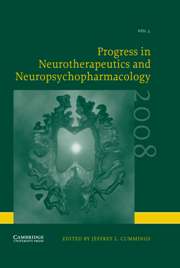No CrossRef data available.
Article contents
Night Eating Syndrome and Results from the First Placebo-Controlled Trial of Treatment, with the SSRI Medication, Sertraline: Implications for Clinical Practice
Published online by Cambridge University Press: 18 December 2007
Extract
ABSTRACT
Objective: The goal of the study was to assess the efficacy of sertraline in the treatment of the night eating syndrome (NES). Method: Thirty-four outpatients diagnosed with NES were randomly assigned to receive either sertraline (n = 17) or placebo (n = 17) in an 8-week, double-blind, flexible-dose (50–200 mg/day) study. We used the mixed effects linear regression model to analyze change in the primary outcome measure, the Clinical Global Impression of Improvement Scale (CGI-I). Secondary outcomes included changes in the Night Eating Symptom Scale (NESS), the number of nocturnal awakenings and ingestions, total daily calorie intake after the evening meal, Clinical Global Impression of Severity Scale (CGI-S), Quality of Life Enjoyment and Satisfaction Scale (Q-LES), and weight. Results: Sertraline was associated with statistically significantly greater improvements than placebo in the CGI-I scale. As determined by a CGI-I score of ≤2 (much or very much improved), 12 subjects in the sertraline group (71%) were classified as responders versus only 3 in the placebo group (18%). There were also significant improvements in the NESS, CGI-S scales, Q-LES, frequency of nocturnal ingestions and awakenings, and calorie intake after supper. Overweight and obese subjects in the sertraline group (n = 14) lost a significant amount of weight by week 8 (mean = −2.9, SD = 3.8 kg) compared to those in the placebo arm (n = 13) (mean = −0.3, SD = 2.7 kg). Conclusions: In this 8-week trial, sertraline was effective in the treatment of NES and was well tolerated.
- Type
- Research Article
- Information
- Progress in Neurotherapeutics and Neuropsychopharmacology , Volume 3 , Issue 1 , January 2008 , pp. 241 - 257
- Copyright
- © 2008 Cambridge University Press




